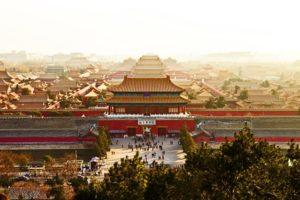Fodor's Expert Review Fahai Temple
The stunning works of Buddhist mural art at Fahai Temple, 20 km (12 miles) west of the central city, are among the most underappreciated sights in Beijing. Li Tong, a favored eunuch in the court of Emperor Zhengtong (1436–49), donated funds to construct Fahai Temple in 1443. The project was highly ambitious: Li Tong invited only celebrated imperial and court painters to decorate the temple. As a result, the murals in the only surviving chamber of that period, Daxiongbaodian (the Mahavira Hall), are considered the finest examples of Buddhist mural art from the Ming Dynasty. Sadly, statues of various Buddhas and one of Li Tong himself were destroyed during China's Cultural Revolution.
The most famous of the nine murals in Mahavira Hall is a large-scale triptych featuring Guanyin (the Bodhisattva of Compassion) and Wenshu (the Bodhisattva of Marvelous Virtue and Gentle Majesty) in the center, and Poxian (the Buddha of Universal Virtue) on either side. The depiction... READ MORE
The stunning works of Buddhist mural art at Fahai Temple, 20 km (12 miles) west of the central city, are among the most underappreciated sights in Beijing. Li Tong, a favored eunuch in the court of Emperor Zhengtong (1436–49), donated funds to construct Fahai Temple in 1443. The project was highly ambitious: Li Tong invited only celebrated imperial and court painters to decorate the temple. As a result, the murals in the only surviving chamber of that period, Daxiongbaodian (the Mahavira Hall), are considered the finest examples of Buddhist mural art from the Ming Dynasty. Sadly, statues of various Buddhas and one of Li Tong himself were destroyed during China's Cultural Revolution.
The most famous of the nine murals in Mahavira Hall is a large-scale triptych featuring Guanyin (the Bodhisattva of Compassion) and Wenshu (the Bodhisattva of Marvelous Virtue and Gentle Majesty) in the center, and Poxian (the Buddha of Universal Virtue) on either side. The depiction of Guanyin follows the theme of "moon in water," which compares the Buddhist belief in the illusoriness of the material world to the reflection of the moon in the water. Typically painted with Guanyin are her legendary mount Jin Sun and her assistant Shancai Tongzi. Wenshu is often presented with a lion, symbolic of the bodhisattva's wisdom and strength of will, while Poxian is shown near a six-tusked elephant, each tusk representing one of the qualities that leads to enlightenment. On the opposite wall is the Sovereign Sakra and Brahma mural, with a panoply of characters from the Buddhist canon.
The murals were painted during the time of the European Renaissance, and though the subject matter is traditional, there are comparable experiments in perspective taking place in the depiction of the figures, as compared with examples from earlier dynasties. Also of note is a highly unusual decorative technique; many contours in the hall's murals, particularly on jewelry, armor, and weapons, have been set in bold relief by the application of fine gold threads.
The temple grounds are also beautiful, but of overriding interest are the murals themselves. Visitors stumble through the dark temple with rented flashlights (free with your ticket). Viewing the murals in this way, it's easy to imagine oneself as a sort of modern-day Indiana Jones unraveling a story of the Buddha as depicted in ancient murals of unrivaled beauty. Fahai Temple is only a short taxi ride from Beijing's Pingguoyuan subway station.
READ LESS







